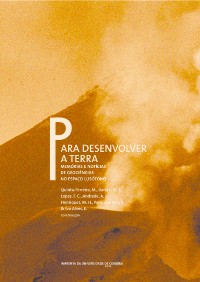Please use this identifier to cite or link to this item:
https://hdl.handle.net/10316.2/31473| DC Field | Value | Language |
|---|---|---|
| dc.contributor.author | Morais, I. | |
| dc.contributor.author | Campos, J. S. | |
| dc.contributor.author | Pratas, J. | |
| dc.contributor.author | Pita, F. | |
| dc.date.accessioned | 2014-06-20T16:00:42Z | |
| dc.date.accessioned | 2020-09-18T17:20:13Z | - |
| dc.date.available | 2014-06-20T16:00:42Z | |
| dc.date.available | 2020-09-18T17:20:13Z | - |
| dc.date.issued | 2012 | - |
| dc.identifier.isbn | 978-989-26-0531-9 (PDF) | |
| dc.identifier.uri | https://hdl.handle.net/10316.2/31473 | - |
| dc.description.abstract | This paper is a preliminary study where is tested the possibility of using Alyssum serpyllifolium susbp. lusitanicum as a bio‑ore in phytomining, using serpentinic soils. This species, endemic to the serpentinic soils of Bragança and Morais massifs, is a Ni hyperaccumulator, and may contain more than 6500 mg/kg (DW) of this element. In this study we intend to verify that the variability of the levels of Ni contained in the plant in different locations, if it is dependent on the Ni contained in the soil or in the bioavailable soil fraction. It also allows develop a pre evaluation of the biomass produced under natural conditions and the amount of nickel that can remove per unit area. The results show that the average production of biomass, considering only the aerial parts is about 7.2 t/ha, with an average grade of 0.41% Ni, allowing withdraw around 27.5 kg/ha per crop, under natural conditions. Considering the depletion of Ni from the soil through successive crops is also found that the serpentine soils may be an important source for the application of phytomining using this plant species. | eng |
| dc.description.abstract | O presente trabalho é um estudo preliminar onde se testa a possibilidade de utilização do Alyssum serpyllifolium susbp. lusitanicum como um biominério na fitomineração de solos serpentiníticos. Esta espécie, endémica dos solos ultrabásicos dos maciços de Bragança e de Morais, é uma hiperacumuladora de Ni, podendo conter mais de 6500 mg/kg (Peso Seco) deste elemento. Pretende‑se verificar qual a variabilidade dos teores de Ni contidos na planta em diferentes locais, se é dependente do Ni contido no solo ou na fracção biodisponível. Elaborar uma pré avaliação da biomassa produzida em condições naturais e da quantidade de níquel que se pode retirar por unidade de área. Os resultados obtidos revelam que a sua produção de biomassa média, considerando apenas as partes aéreas, é de cerca de 7,2 t/ha, com um teor médio 0,41% Ni (0,38% de Ni teor ponderado), permitindo retirar cerca de 27,5 kg/ha por colheita, em condições naturais. Considerando a depleção de Ni do solo por sucessivas colheitas verifica‑se também que os solos serpentiníticos podem ser uma fonte importante para a aplicação da fitomineração utilizando esta espécie. | por |
| dc.language.iso | por | - |
| dc.publisher | Imprensa da Universidade de Coimbra | por |
| dc.relation.ispartof | http://hdl.handle.net/10316.2/24404 | por |
| dc.rights | open access | - |
| dc.subject | Phytomining | eng |
| dc.subject | Nickel | eng |
| dc.subject | Alyssum | eng |
| dc.subject | Serpentinic soils | eng |
| dc.subject | Bragança | eng |
| dc.subject | Fitomineração | por |
| dc.subject | Níquel | por |
| dc.subject | Alyssum | por |
| dc.subject | Solos serpentiníticos | por |
| dc.subject | Bragança | por |
| dc.title | Estudo preliminar de fitomineração utilizando alyssumserpyllifoliumdesf. subsp. lusitanicum (Dudley& P. Silva) em solos serpentiníticos dos maciços de Bragança e de Morais (nordeste de Portugal) | por |
| dc.title.alternative | Preliminary studie of phytomining using alyssum serpyllifolium desf. subsp. lusitanicum (Dubley & P. Silva) in serpentinic soils of Bragança and Morais masifs (northeast of Portugal) | eng |
| dc.type | bookPart | por |
| uc.publication.firstPage | 341 | - |
| uc.publication.lastPage | 350 | - |
| uc.publication.location | Coimbra | por |
| dc.identifier.doi | 10.14195/978-989-26-0531-9_34 | - |
| uc.publication.digCollection | PB | por |
| uc.publication.orderno | 35 | - |
| uc.publication.area | Ciências Naturais | por |
| uc.publication.bookTitle | Para desenvolver a Terra: memórias e notícias de Geociências no espaço lusófono | - |
| uc.publication.manifest | https://dl.uc.pt/json/iiif/10316.2/31473/218928/manifest?manifest=/json/iiif/10316.2/31473/218928/manifest | - |
| uc.publication.thumbnail | https://dl.uc.pt/retrieve/11297757 | - |
| uc.publication.parentItemId | 52112 | - |
| uc.itemId | 71926 | - |
| item.grantfulltext | open | - |
| item.fulltext | With Fulltext | - |
| Appears in Collections: | Para desenvolver a Terra: memórias e notícias de Geociências no espaço lusófono | |
Files in This Item:
| File | Description | Size | Format | |
|---|---|---|---|---|
| 34-para_desenvolver_a_terra_artigo..pdf | 1.47 MB | Adobe PDF |  |
Items in DSpace are protected by copyright, with all rights reserved, unless otherwise indicated.
